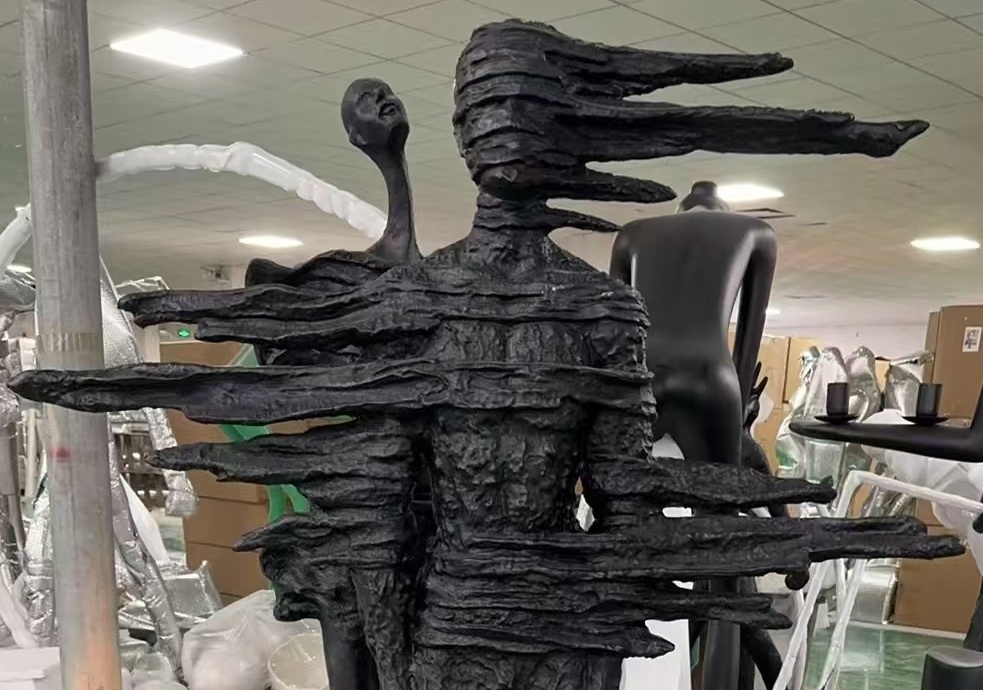Sculpture, an ancient and eternal art form, has been telling human thoughts, emotions and pursuits in a unique language since ancient times. It is not only a physical existence in the material world, but also an abstract expression of the spiritual world. Through the shaping of three-dimensional space, the artist’s creativity and emotions are fixed in the long river of time. The artistic charm of sculpture lies in its ability to transcend the boundaries of time and space, allowing viewers to resonate with the work in silence and feel a profound power beyond words.
- Definition and scope of sculpture
In short, sculpture is based on material materials (such as stone, wood, metal, ceramics, plastics, etc.), through carving, shaping, casting and other means to create artistic images with a three-dimensional sense of space. These images can be concrete figures, animals, plants, or abstract geometric forms, symbols, and even the externalization of the artist’s inner emotions and concepts. Sculpture art involves a wide range of styles and schools, from classicism to modernism, from realism to surrealism, and each style carries the cultural characteristics and aesthetic tendencies of a specific historical period.
The scope of sculpture is extremely broad, including large public sculptures, such as monuments in city squares and decorative sculptures in gardens, as well as small indoor sculptures, such as desk ornaments and decorative wall decorations. In addition, with the development of modern art, the forms and media of sculpture are also constantly expanding, and new forms of sculpture such as soft sculpture (using materials such as cloth and fiber), light sculpture (using light and projection), and sound sculpture (combining sound elements) have emerged, further enriching the connotation and extension of sculpture art.
- The historical evolution of sculpture
The history of sculpture is almost synchronized with the history of human civilization. It can be traced back to the stone tools of prehistoric times. These tools inadvertently showed the exploration and pursuit of human craftsmanship during the production process. With the progress of society, sculpture gradually separated from practical functions and became an independent art form.
Ancient sculpture: Ancient Egyptian sculpture is famous for its strict frontal law and eternal death theme. The Sphinx and Pharaoh statues next to the pyramids still attract the world’s attention with their solemnity and mystery. Ancient Greek sculptures pursued the perfect proportions and dynamic balance of the human body. Michelangelo’s “David” is an outstanding representative of this tradition, showing the ultimate beauty of human strength. Ancient Roman sculptures inherited the Greek tradition and developed a more realistic and narrative style on this basis.
Medieval sculptures: During this period, religious themes became the main content of sculptures. The statues of the Virgin and Child, saints, and a large number of religious reliefs inside and outside the church conveyed the yearning for holiness and salvation. Gothic sculptures, with their towering and upright, clever use of light and shadow, add a mysterious and sublime atmosphere to religious spaces.
Renaissance to modern times: During the Renaissance, sculpture art ushered in a new prosperity. Artists not only pursued exquisite skills, but also paid more attention to the expression of emotions and the display of personality. Baroque and Rococo styles are known for dynamic exaggeration and delicate softness, respectively, showing the aesthetic tastes of different eras. Entering the 19th century, with the invention of photography and the acceleration of the industrialization process, sculpture art began to explore new ways of expression and materials. Realism, Impressionism, Symbolism and other schools emerged one after another, injecting new vitality into sculpture art.
Modern and Contemporary Sculpture: Since the 20th century, with the great changes in global politics, economy and culture, sculpture art has also experienced unprecedented innovation and change. Pioneer art movements such as Cubism, Futurism and Surrealism have completely subverted the concept and form of traditional sculpture. Sculpture is no longer limited to static three-dimensional entities, but has expanded to the diversification of time, space, materials and even concepts. Through deconstruction and reconstruction, artists explore the relationship between sculpture and the audience and the environment, as well as the infinite possibilities of sculpture as an artistic medium.
- Artistic Language and Expression Techniques of Sculpture
The artistic language of sculpture mainly includes shape, volume, space, material, color (although traditional sculptures are mostly monochrome or natural material colors), etc. These elements together constitute the visual and tactile experience of sculpture works.
Shape and Volume: Sculpture creates rich visual layers and a sense of depth through changes in form and shaping of volume. Artists add or subtract materials to make their works appear rounded or angular, thereby conveying specific emotions or ideas.
Space: Sculpture is the art of three-dimensional space. Artists create open, closed, dynamic or static spatial feelings through the layout of the work and the viewer’s perspective design. The interaction between sculpture and the surrounding environment is also an important part of spatial language.
Material: The choice of material not only affects the physical properties of the sculpture, such as weight, texture, gloss, etc., but also carries specific cultural significance and symbolic value. From natural stone and wood to artificial metal and plastic, each material tells a story in its own unique way.
Color: Although traditional sculptures often rely on the natural color of the material, in modern sculptures, color is increasingly used to enhance the visual impact of the work or express a specific emotional atmosphere.
Sculpture has various expression techniques, including carving (subtractive sculpture), shaping (additive sculpture), casting, welding, weaving, etc. Artists flexibly use these techniques according to their creative intentions and material characteristics to create works of various forms and unique styles.
- Social Functions and Influences of Sculpture
As a form of public art, sculpture has a social function far beyond aesthetic pleasure. It also plays multiple roles such as cultural inheritance, historical record, social criticism, and spiritual comfort.
Cultural inheritance and historical witness: Sculpture is a carrier of history and culture. Through concrete or abstract images, it records the development trajectory and important events of human society, such as war monuments and statues of historical figures, and becomes a bridge connecting the past and the future.
Social criticism and ideological enlightenment: Modern sculpture art is often highly critical and reflective. Through works, it deeply analyzes social phenomena, political systems, human conditions, etc., stimulates public thinking and discussion, and promotes social progress.
Spiritual comfort and emotional resonance: Sculpture works, with their unique form and texture, touch people’s hearts and become a carrier of people’s emotional sustenance. Whether it is a large sculpture in a city square or a small ornament in a personal space, it can give people spiritual comfort and strength to varying degrees.
Beautification and revitalization of public space: As an important part of the urban landscape, sculpture not only beautifies the environment, but also enhances the cultural taste of public space, promotes community vitality, and enhances residents’ cultural identity and sense of belonging.
Conclusion
Sculpture, an ancient and ever-new art form, with its unique charm, transcends the boundaries of time and space, connecting the human mind and the natural world. It is not only the crystallization of the artist’s creativity, but also a witness and disseminator of human civilization. In the years to come, with the continuous advancement of science and technology and the continuous renewal of artistic concepts, sculpture art will continue to explore new boundaries, create more amazing works, and add endless color and depth to the human spiritual world. Sculpture, as a solidified art, is silently communicating with time in its unique way, telling stories about life, love and dreams.


